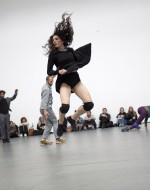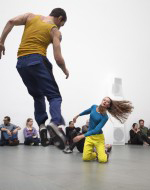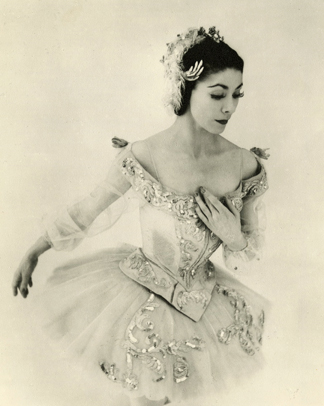Dance: Past and Present
By Dawn Lille
ART TIMES January 2014 online
Change has always been a part of artistic creativity and the massive takeover by technology in this century has produced various new procedures and results. It is therefore most interesting that two recent events in the dance world, coming from two different sources, neither especially technological, attracted considerable attention.
 Suspension of Conflicts Extended |
The Museum of Modern Art presented Musee de la danse: Three Collective Gestures, by the French artist Boris Charmatz over three weekends commencing October 18. The Dance Collection of the Library of Performing Arts at Lincoln Center presented a discussion of the ballet Sleeping Beauty by Alastair Macaulay, chief dance critic for the New York Times, Robert Greskovic, an historian and critic who writes for the Wall Street Journal, and David Vaughan, dance historian, critic and archivist, which packed the Bruno Walter auditorium on November 4.
Charmatz, who is 40 yeas old, is a dancer trained at the Paris Opera, a choreographer and head of the Centre choregraphique national de Rennes et de Bretagne [National Choreographic Center of Rennes and Bretagne]. He has written extensively about his art and one piece, a manifesto, proposed eliminating the words national, choreographic and center and replacing them with Musee de la danse [Museum of the Dance] – a change that was made.
He feels that the dance of modern times has no need for a center, but should be a space allowing room for a broad living dance. It needs to “ go well beyond the restricted circle of those who structure it in everyday life and open itself up to an anthropological dimension that joyfully explodes….”
He and his group in northwestern France have been concerned with new ways of using the past and of approaching the future of dance. His emphasis is on space that is public space and he wishes to use it and expand it in ways that change the perception of the viewer. He has said that if one wishes “ to pursue the new technological trends … then it seems… that under the designation of Museum” the artists will be able to have fun and create freely. Technology is allowing something different to emerge and a museum can be alive and inhabited. In effect he proposed changing the concept of a museum by means of dance.
The three “gestures” or works at MOMA were 20 Dances for the XX Century, Levee des Conflicts Extended and Flip Book, each reflecting different ways of thinking about dance via the museum.
 Suspension of Conflicts Extended |
The first involved 20 dancers performing solos by 20 choreographers who were important parts of 20th century dance (e.g. Ted Shawn) in different rooms or areas. This use of the museum space as a container of history was interesting, but since there were no directions or signage viewers just “happened” upon them. The last, an homage of sorts to Merce Cunningham, took place in the atrium, where seating had been set up, and was based on photographs in a book on this seminal and groundbreaking choreographer. It was a bit static in performance.
But the second gesture, Levee des Conflicts Extended [Suspension of Conflicts Extended], presented in front of a standing (or lying or squatting) audience in the atrium and on the floors above, allowed them to feel they were viewing the creation of a tapestry in motion. A total of 25 set movements were performed by 24 dancers in different groupings. Dancers entered one by one to join the performance that was accompanied by both music and sound scores.
The tapestry grew, becoming richer and richer as the different movement became recognizable, and their occurrence was akin to seeing an old friend evolve into a new person. By the end this “living tapestry” seemed to fill the entire museum and it was exhilarating.
 Margo Fonteyn |
The three-way conversation on Sleeping Beauty took place at a table on the side of the stage at Bruno Walter Auditorium. The words were constantly reinforced by films, some not previously seen and several of Margot Fonteyn. There were also wonderful slides of the Gustave Dore illustrations of the story, which had influenced the original production, all from the Dance Collection.
The original ballet, choreographed in Russia in 1890 by Marius Petipa, was based on the story by Perrault with glorious music written to order by Tchaikovsky, and has been seen in many different versions. Among them is a 1914 production familiar to Balanchine, one in 1916 featuring Pavlova, a version in 1921 by Diaghilev (who, although very much the avant -gardist was adamant about the importance of this ballet) and a staging for the Sadler-Wells in England which became the international standard when that company became the Royal Ballet. In New York today there are versions in American Ballet Theatre and the New York City Ballet, both “after Petipa.”
David Vaughan pointed out that, aside from depicting the forces of good vs. evil, Sleeping Beauty also paints a picture of chivalry and concerns the relationship between male and female. The story is about the princess (Aurora), who is cursed at her baptism to die of a pricked finger at age 16 by the wicked fairy Carabosse, who was unintentionally left off the guest list. She is saved by the Lilac Fairy, whose gift is that she and the court will sleep for 100 years and come to life through the kiss of a prince who falls in love with her.
The ballet is propelled by its pas d'action or dance that furthers the action: the Dance of the Fairies in the Prologue, the Rose Adagio (in which Aurora is courted by four men at her coming of age party) in Act I, the Vision Scene in which the Lilac Fairy tells the Prince about Aurora and leads him to her in Act II, and the wedding pas de deux in Act III.
The panel emphasized that this work is an example of western classical art and that, as a ballet, it exhibits the perfection of form, which, when viewed in some of the films, caused those present to gasp. Aurora’s signature movement is a first arabesque. Here the dancer is in profile to the audience, balanced on one leg, with the other leg (that nearest the audience) stretched straight behind at a 90-degree angle. The arm of the standing leg is stretched forward, the other arm backward and parallel to the leg, with hands long and palms facing the floor. There is an unbroken line from the fingers of the front hand to the toes of the extended leg.
It does not seem relevant to spend time on the possibility of a moral in Sleeping Beauty. What is important is that it is a ballet about the perfection of form.
In considering these two events one can speculate that Charmatz might have included Sleeping Beauty in his first weekend and called it “Dance of the late 19th and 20th century, “ because, historically and aesthetically, this ballet should not and, hopefully, will not disappear. It can remain in the dance arena, or museum, as he likes to call it, alongside current and experimental works.
T.S. Eliot, in his essay Tradition and the Individual Talent, stressed the importance of a historical sense to any artist, emphasizing that there must be an awareness of the past at the same time one is changing the present. How fortunate to be able to experience these two events!
dawnlille@aol.com
